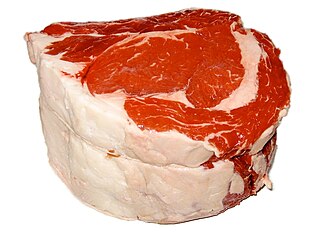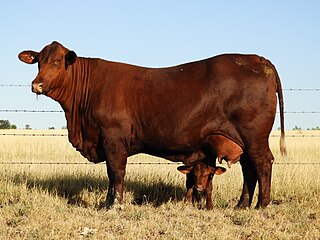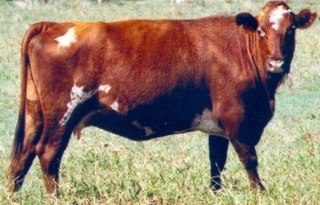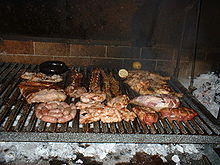
Beef is the culinary name for meat from cattle. Beef can be prepared in various ways; cuts are often used for steak, which can be cooked to varying degrees of doneness, while trimmings are often ground or minced, as found in most hamburgers. Beef contains protein, iron, and vitamin B12. Along with other kinds of red meat, high consumption is associated with an increased risk of colorectal cancer and coronary heart disease, especially when processed. Beef has a high environmental impact, being a primary driver of deforestation with the highest greenhouse gas emissions of any agricultural product.

The Aberdeen Angus, sometimes simply Angus, is a Scottish breed of small beef cattle. It derives from cattle native to the counties of Aberdeen, Banff, Kincardine and Angus in north-eastern Scotland. In 2018 the breed accounted for over 17% of the beef production in the United Kingdom.

Kobe beef is Wagyu beef from the Tajima strain of Japanese Black cattle, raised in Japan's Hyōgo Prefecture according to rules set out by the Kobe Beef Marketing and Distribution Promotion Association. The meat is a delicacy, valued for its flavour, tenderness and fatty, well-marbled texture. Kobe beef can be prepared as steak, sukiyaki, shabu-shabu, sashimi, and teppanyaki. Within Japan, Kobe is one of the three Sandai Wagyū, the "three big beefs", along with Matsusaka beef and Ōmi beef or Yonezawa beef.

The Dairy Shorthorn is a British breed of dairy cattle. It derives from the Shorthorn cattle of Teesside, in the North Riding of Yorkshire and in Northumbria in north-eastern England. The Shorthorn was for this reason at first known as the Durham or Teeswater.

Wagyu is the collective name for the four principal Japanese breeds of beef cattle. All wagyū cattle derive from cross-breeding in the early twentieth century of native Japanese cattle with imported stock, mostly from Europe.

The Murray Grey is an Australian breed of polled beef cattle. It originated between 1905 and 1917 in the upper Murray River valley, on the border between New South Wales and Victoria. It is similar in appearance to the Aberdeen Angus, from which it largely derives, but is grey, silver or dun in colour.

The Afrikaner or Africander is an African breed of taurine-indicine cattle in the Sanga group of African cattle. It is derived from the cattle of the Khoikhoi (Hottentot) people which were already present in the area of modern South Africa when the Dutch East India Company established the Cape Colony in 1652.

The Brangus is an American hybrid breed of beef cattle derived from cross-breeding of American Angus and Brahman stock. Registered animals have 5/8 Angus and 3/8 Brahman parentage. A similar hybrid breed, the Australian Brangus, was separately developed in Australia from about 1950.

The Limousin, French: Limousine, is a French breed of beef cattle from the Limousin and Marche regions of France. It was formerly used mainly as a draught animal, but in modern times is reared for beef. A herd-book was established in France in 1886. With the mechanisation of agriculture in the twentieth century, numbers declined. In the 1960s there were still more than 250 000 head, but the future of the breed was not clear; it was proposed that it be merged with the other blonde draught breeds of south-western France – the Blonde des Pyrénées, the Blonde de Quercy and the Garonnaise – to form the new Blonde d'Aquitaine. Instead, a breeders' association was formed; new importance was given to extensive management, to performance recording and to exports. In the twenty-first century the Limousin is the second-most numerous beef breed in France after the Charolais. It is a world breed, raised in about eighty countries round the world, many of which have breed associations.

The Shorthorn breed of cattle originated in the North East of England in the late eighteenth century. The breed was developed as dual-purpose, suitable for both dairy and beef production; however, certain blood lines within the breed always emphasised one quality or the other. Over time, these different lines diverged, and by the second half of the twentieth century, two separate breeds had developed – the Beef Shorthorn, and the Milking Shorthorn. All Shorthorn cattle are coloured red, white, or roan, although roan cattle are preferred by some, and completely white animals are not common. However, one type of Shorthorn has been bred to be consistently white – the Whitebred Shorthorn, which was developed to cross with black Galloway cattle to produce a popular blue roan crossbreed, the Blue Grey.

The Santa Gertrudis is an American breed of beef cattle. It is a taurine-indicine hybrid breed, descended from both zebu and European cattle. It was bred in the early twentieth century in Texas, and received official recognition in 1940. It has been exported to many countries including Australia, Brazil and South Africa, and has contributed to the development of a number of modern breeds, among them the Barzona and the Droughtmaster.
Argentina is one of the world's largest producers of beef. It is also the third-largest exporter, and has the world's highest consumption rate. On 8 March 2006, President Néstor Kirchner took the drastic measure of banning all exports of beef for a period of 180 days, in order to stop continuous price rises.

Luing cattle are a beef breed developed on the island of Luing in the Inner Hebrides of Scotland by the Cadzow brothers in 1947. It was formed by first crossbreeding Beef Shorthorn with Highland cattle and then breeding the resulting progeny with Beef Shorthorns to produce an animal three quarters Beef Shorthorn, one quarter Highland. The breed of red-brown cattle are moderately sized and extremely hardy. The intent was to produce a good beef cow with the ability to raise a calf under adverse weather conditions. It was officially recognised as a breed by the British government in 1965. The breed is still farmed today, mainly in Scotland but also in other areas of the world.

The Japanese Black is a breed of Japanese beef cattle. It is one of six Japanese cattle breeds, and one of the four Japanese breeds known as wagyū, the others being the Japanese Brown, the Japanese Polled and the Japanese Shorthorn. All wagyū cattle derive from cross-breeding in the early twentieth century of native Japanese cattle with imported stock, mostly from Europe. In the case of the Japanese Black, the foreign influence was from European breeds including Braunvieh, Shorthorn, Devon, Simmental, Ayrshire and Holstein.

The Australian Charbray is an Australian breed of cattle derived from a cross between the French Charolais cattle and American Brahman cattle. The charbray breed was first conceived in the United States of America in the 1930s and later introduced into Australia in 1969. In Australia, Australian charbray breeders are concentrated in the tropical Northern regions of Queensland. As of 1977, the official breeder society of Charbray cattle in Australia and New Zealand is the Charbray Society of Australia Limited, responsible for recording Charbray cattle in herd books, fostering improvement, enhancement and sales of Charbray cattle.

The Japanese Brown is a breed of small Japanese beef cattle. It is one of six native Japanese cattle breeds, and one of the four Japanese breeds known as wagyū, the others being the Japanese Black, the Japanese Polled and the Japanese Shorthorn. All wagyū cattle derive from cross-breeding in the early twentieth century of native Japanese cattle with imported stock, mostly from Europe. In the case of the Japanese Brown, the principal foreign influence was from the Korean Hanwoo and Swiss Simmental breeds.

The Adaptaur is a tropically-adapted Bos taurus beef cattle breed which was developed in Australia in the 1950s from crosses between Herefords and Shorthorns.

A steak is a thick cut of meat generally sliced across the muscle fibers, sometimes including a bone. It is normally grilled or fried. Steak can be diced, cooked in sauce, such as in steak and kidney pie, or minced and formed into patties, such as hamburgers.

The Japanese Shorthorn is a breed of small Japanese beef cattle. It is one of six native Japanese cattle breeds, and one of the four Japanese breeds known as wagyū, the others being the Japanese Black, the Japanese Brown and the Japanese Polled. All wagyū cattle derive from cross-breeding in the early twentieth century of native Japanese cattle with imported stock, mostly from Europe. In the case of the Japanese Shorthorn, the principal foreign influence was from the Shorthorn, with some contribution from the Ayrshire and Devon breeds.
The Japanese Polled is a critically-endangered breed of small Japanese beef cattle. It is one of six native Japanese cattle breeds, and one of the four Japanese breeds known as wagyū, the others being the Japanese Black, the Japanese Brown and the Japanese Shorthorn. All wagyū cattle derive from cross-breeding in the early twentieth century of native Japanese cattle with imported stock, mostly from Europe. In the case of the Japanese Polled, the principal foreign influence was from the Scottish Angus breed.






















